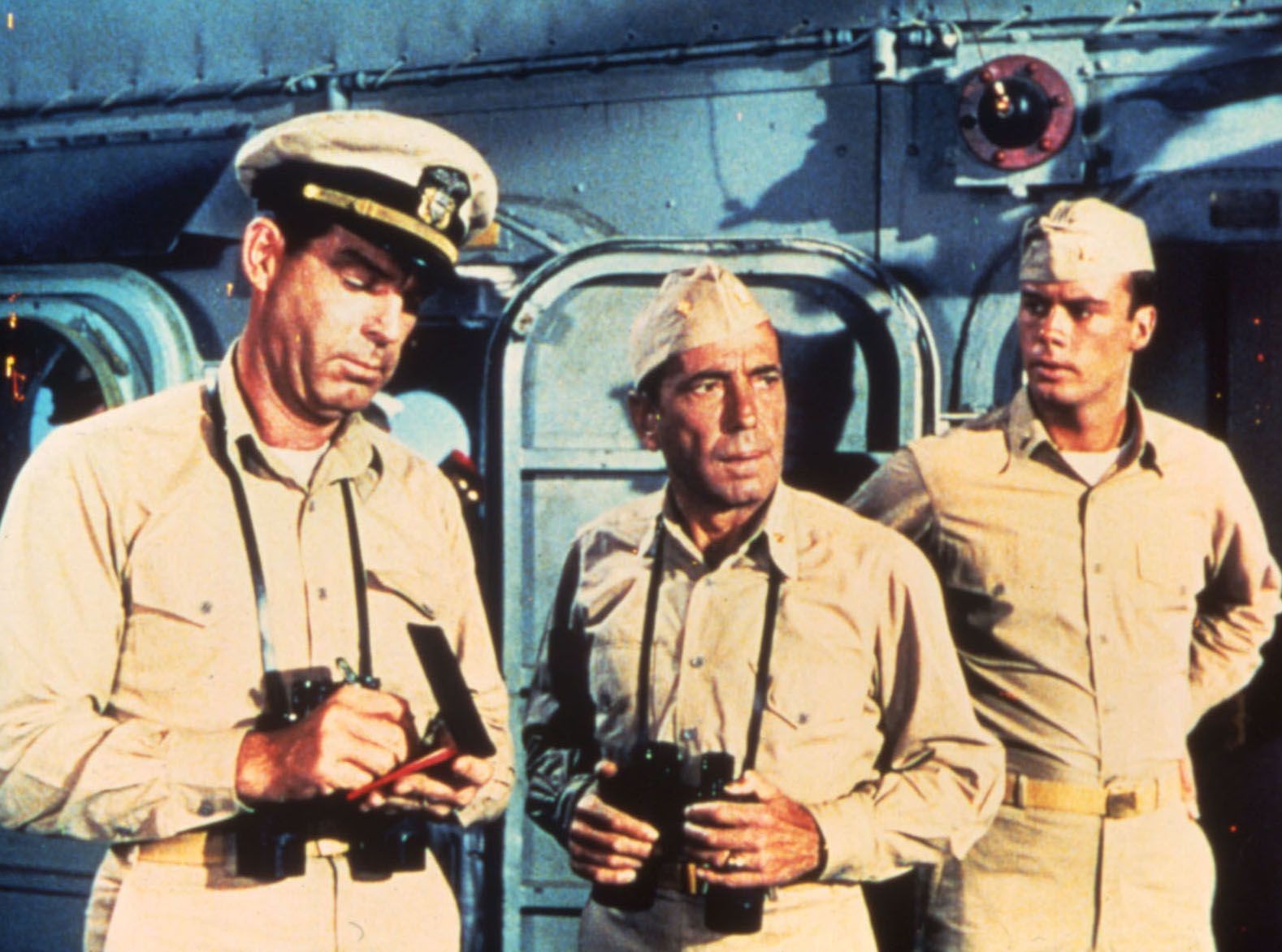
The Caine Mutiny–nominated for seven Oscars–will be marking the 70th anniversary of its 1954 theatrical release this upcoming June.
Stanley Kramer had quite interesting profile as a director but he isn’t directing the film. If you’re familiar with Kramer as a filmmaker, it means that you already know that he had an equally successful career as an independent producer. Anyway, he acquired the rights to Herman Wouk’s novel before it became a bestseller. Initially, the U.S. Navy did not want to cooperate with the filmmakers because of the mutiny aspect. They eventually came around to offering the film its support.
Edward Dmytryk, who directed the film, had been one of the Hollywood Ten in 1947. He later named names and was hired by Stanley Kramer in 1952. First up were a trio of low-budget films and then of course, this one. Previously nominated for Crossfire as a director, he missed out on an directing nomination for The Caine Mutiny. It’s easily the best known film in his filmography.
The film is completely fictitious in depicting a non-violent mutiny aboard a destroyer-minesweeper that is serving as part of the Pacific front in World War II. Our introduction to the USS Caine is by way of Ensign Willis Seward “Willie” Keith (Robert Francis). The newly commissioned officer meets the crew but is not too fond of hits commanding officer, Lieutenant Commander William De Vriess (Tom Tully). Keith also meets a pair of officers, Lt. Stephen Maryk (Van Johnson) and Lt. Thomas Keefer (Fred MacMurray). Anyway, De Vriess is soon relieved by the ship’s new commanding officer, Lt. Cdr. Philip Francis Queeg (Humphrey Bogart). Queeg’s commanding style is different from his predecessor, preferring to go by the book.
After an earlier incident, there’s a confrontation between Lt. Cdr. Queeg and Lt. Maryk comes during the typhoon. It may be one thing to question someone’s command but it’s another to order his crew to take the ship into a typhoon. You’d have to be out of your mind to make such a fakakta order! And yet, this is exactly what Queeg does, much to his crew’s dismay. I can’t blame Maryk for leading the crew in mutiny and the court proves him right in acquitting him following a court-martial for treason. Keith is also court-martialed but we never hear the decision. That said, we do know that he gets a promotion and then assigned to another destroyer commanded by Cdr. William H. De Vriess, much to his dismay. What is it that people say about karma?
Humphrey Bogart gets first billing here but the film is more of an ensemble piece. Bogart, sadly, is basically at the tail end of his career but he could gets butts in seats. When a studio gives a role to Bogie, they’re going to make sure it is worth his salary. His casting is probably a key reason why the film performed so well in 1954. If not for Marlon Brando in On the Waterfront, the Oscar for Best Actor would have been in his hands. Back to the film’s ensemble nature, one can see why Wouk would end up adapting his novel into a theatrical play. Anyway, I feel that Robert Francis gets more screen time than Bogie himself–he’s our way into the movie. It’s a shame that he died at such a young age. In any event, Wouk’s novel focuses more so on Keith than Queeg.
While the film is an ensemble piece, the ensemble nature is never more true than during its second half. This is where it moves into the courtroom drama genre. Unfortunately, Columbia Pictures would impact the film by having a mandate to make it two hours long. Those cuts were made not by screenwriter Stanley Roberts but Michael Blankfort. You could probably add another hour to the film by really putting the courtroom drama on display. Interestingly, The Caine Mutiny Court-Martial premiered on stage and Broadway months before the film opened in theaters. The recent William Friedkin-directed adaptation ran for 109 minutes. Regardless, photography had wrapped before the Broadway premiere.
As mentioned earlier, the film earned seven Oscar nominations for Best Picture, Actor (Bogart), Supporting Actor (Tom Tully), Screenplay, Editing, Original Score, and Sound Recording. In terms of the score, Max Steiner‘s thematic march, “Full Speed Ahead,” is a very catchy tune but it feels very similar to “Anchors Aweigh.” It’s naval in tone, of course, but doesn’t quite capture the drama about to ensue. Steiner’s march, if anything, is to alleviate the Navy’s concerns surrounding the mutiny. It would be Steiner’s final score on a Kramer production, not that the film offers much of a showcase for the score in a 2-hour plus runtime. The score itself runs just shy of an hour in the 2017 soundtrack release.
Interestingly enough, the film’s legacy includes the language in the 25th Amendment. The current language makes it harder to invoke the 25th Amendment should the vice president or cabinet officers feel that the president is disabled. They didn’t want any kind of an Article 184 situation. Could you blame them? Mind you, they did not foresee Donald Trump rising into office and inciting an insurrection.
As The Caine Mutiny approaches seventy years, Bogie is impressive as ever and the film remains an equally impressive ensemble drama.
DIRECTOR: Edward Dmytryk
SCREENWRITER: Stanley Roberts
ADDITIONAL DIALOGUE: Michael Blankfort
CAST: Humphrey Bogart, José Ferrer, Van Johnson, Fred MacMurray, and introducing Robert Francis, May Wynn, with Tom Tully, E.G. Marshall, Arthur Franz, Lee Marvin, Warner Anderson, Claude Akins, Katherine Warren, Jerry Paris, Steve Brodie
Columbia Pictures released The Caine Mutiny in theaters on June 24, 1954. Grade: 4/5
Please subscribe to Solzy at the Movies on Buttondown.





